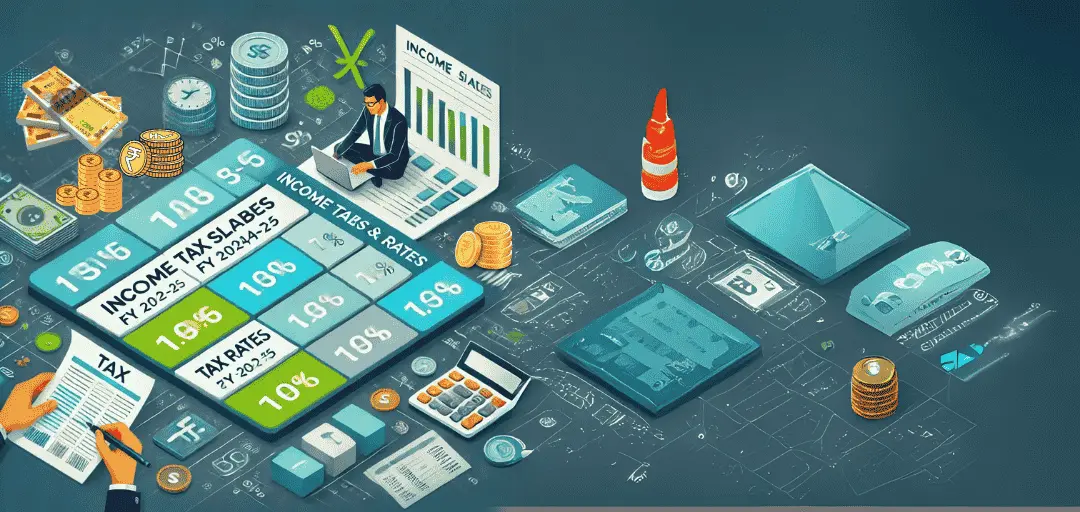Income Tax Slabs & Rates for FY 2024-25
The financial year 2024-25 brings new updates to the Indian income tax system, impacting salaried individuals, self-employed professionals, and businesses. Understanding the income tax slabs 2024 25 is crucial for efficient tax planning and compliance. In this article, we will provide a detailed breakdown of the latest income tax slabs 2024 25, rates, and key changes that you need to be aware of.
Understanding Income Tax Slabs 2024-25
Income tax in India is levied based on a progressive taxation system, meaning individuals with higher incomes pay higher tax rates. The government has introduced two tax regimes: the old tax regime (which includes various deductions and exemptions) and the new tax regime (which offers lower tax rates but fewer exemptions). Taxpayers can choose between these regimes based on their financial preferences.
Income Tax Slabs 2024-25 Under the New Tax Regime
The new tax regime has gained popularity due to its simplified structure and lower tax rates. Below is the latest structure for the income tax slabs 2024 25:
| Annual Income (₹) | Tax Rate |
|---|---|
| Up to ₹2,50,000 | Nil |
| ₹2,50,001 – ₹5,00,000 | 5% |
| ₹5,00,001 – ₹7,50,000 | 10% |
| ₹7,50,001 – ₹10,00,000 | 15% |
| ₹10,00,001 – ₹12,50,000 | 20% |
| ₹12,50,001 – ₹15,00,000 | 25% |
| Above ₹15,00,000 | 30% |
Under this regime, individuals earning up to ₹7 lakh can claim a rebate under Section 87A, effectively making their tax liability zero. The income tax slabs 2024 25 under this regime simplify taxation for many taxpayers.
Income Tax Slabs 2024-25 Under the Old Tax Regime
For taxpayers who prefer claiming deductions and exemptions, the old tax regime remains an option. The income tax slabs 2024 25 under the old tax regime are:
| Annual Income (₹) | Tax Rate |
|---|---|
| Up to ₹2,50,000 | Nil |
| ₹2,50,001 – ₹5,00,000 | 5% |
| ₹5,00,001 – ₹10,00,000 | 20% |
| Above ₹10,00,000 | 30% |
Taxpayers under the old regime can avail deductions under sections such as 80C, 80D, and HRA exemptions, making it beneficial for those with substantial investments. The choice between the income tax slabs 2024 25 under both regimes depends on individual financial goals.
Key Differences Between the Two Tax Regimes
- Lower Tax Rates vs. Deductions: The new tax regime offers lower tax rates but removes most exemptions and deductions available under the old regime.
- Flexibility: Taxpayers can switch between the two regimes each year, except for those with business income.
- Who Should Opt for Which?: If you have minimal investments, the new regime is beneficial. However, if you maximize deductions, the old regime may be a better choice. Comparing the income tax slabs 2024 25 for both regimes can help in decision-making.
Changes and Updates in Income Tax for FY 2024-25
The government periodically updates tax laws to align with economic conditions. Here are some expected changes in the income tax slabs 2024 25:
- Increase in Standard Deduction: There might be an increase in the standard deduction limit to benefit salaried individuals.
- HRA and 80C Benefits: Some experts predict a rise in the limit for 80C deductions and HRA exemptions to boost savings and investments.
- Rebate Under Section 87A: The rebate limit could be adjusted to offer relief to middle-income taxpayers.
Tax Planning Tips for FY 2024-25
To optimize your tax liability, consider the following strategies:
- Choose the Right Tax Regime: Evaluate whether the new or old regime suits your financial situation better. Analyzing the income tax slabs 2024 25 will help you make an informed decision.
- Maximize Deductions: If you opt for the old regime, use deductions under 80C (investments), 80D (health insurance), and HRA (house rent allowance).
- Invest in Tax-Saving Instruments: PPF, ELSS, NPS, and tax-saving FDs can help reduce taxable income.
- Utilize Section 87A: If your total taxable income is within the rebate limit, ensure you take full advantage of the available rebate. Understanding the income tax slabs 2024 25 is essential for effective planning.
Filing Income Tax Returns for FY 2024-25
Filing income tax returns (ITR) accurately and on time is essential to avoid penalties. Key points to keep in mind:
- ITR Deadline: The due date for salaried individuals is typically 31st July 2025.
- E-Filing: The Income Tax Department offers an online e-filing portal for easy tax return submissions.
- Documents Required: Keep your Form 16, salary slips, investment proofs, and bank statements handy while filing.
Ensuring compliance with the income tax slabs 2024 25 is crucial while filing your returns. Stay informed about tax updates to avoid unnecessary tax liabilities.
Conclusion
Understanding the income tax slabs 2024 25 is crucial for effective financial planning. Whether you choose the new or old tax regime, making informed decisions will help optimize your tax outflow. Stay updated with the latest tax regulations and take advantage of deductions and exemptions to maximize your savings. If required, consult a tax expert to ensure compliance and efficient tax planning. Making the right choice between the income tax slabs 2024 25 under both regimes can significantly impact your financial health.
Our GST Services

All E-commerce Tax services
E-commerce tax services help online sellers navigate GST registration, compliance, return filing, TCS management, tax planning, and audits, ensuring efficient tax management and legal compliance.

GST Filing
GST filing is the process of submitting tax returns to the government, detailing sales, purchases, and taxes paid or collected, ensuring compliance with GST laws.

GST Registration
GST registration is the process where businesses obtain a GSTIN from the government, allowing them to collect taxes, claim input tax credits, and comply with GST laws.





